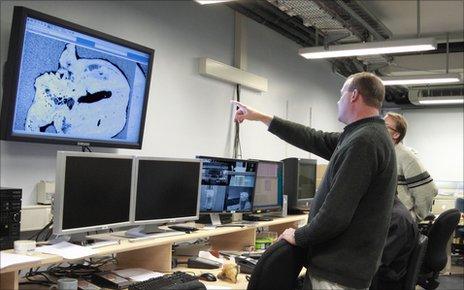Hi-tech scans reveal brain of human 'ancestor'
- Published

Researchers were able to reconstruct a virtual brain cast of the humanlike creature
Paul Tafforeau is a busy man. For the past few years, he has been pioneering a technique that is now beginning to transform our understanding of the past.
He uses high-powered X-rays to "see inside" fossils, producing images that reveal never-before-seen detail.
Dr Tafforeau works at the European Synchrotron Radiation Facility (ESRF) in Grenoble, France, which can produce the intense, high-energy light needed for these experiments.
The imposing mountains of the Rhone-Alpes rise like green sentinels above the glimmering silver "doughnut" that houses the ESRF's X-ray labs and beam equipment.
Dr Tafforeau is a victim of his own success; in the last year, requests have been pouring in from scientists around the world who are keen to use the "micro-tomography" technique on their fossils.
So the ESRF will soon have to assign another X-ray beam exclusively for use on palaeontology projects.
Among other things, the technique has been used to reveal - in exquisite detail - the forms of extinct insects trapped in amber, animals unseen by any eyes since the age of the dinosaurs.
"It can be considered a powerful approach to see more details [on a fossil]," Dr Tafforeau told BBC News.

Dr Tafforeau's technique can reveal striking detail in fossilised specimens
New analyses of fossils belonging to a humanlike creature, or hominin, have just been published in the prestigious journal Science.
The well preserved remains of Australopithecus sediba were unearthed at a site outside Johannesburg in South Africa in 2008. The emerging picture is one that places A. sediba close to the ancestral path that led to our own species.
Among the results presented in Science is a high-resolution scan of the hominin's skull, carried out in Dr Tafforeau's lab. By scanning the imprint left on the inside of the animal's skull, they were able to produce a virtual cast of A. sediba's brain.
It shows that, although the hominin's brain was small - smaller in fact than other primitive hominins - it already had very humanlike characteristics.
The fossils, which are considered a national treasure by the South African government, were delivered to the ESRF for scanning under a police escort.
"By using synchrotron X-rays, you can access more [features] than you can by just using your eyes or conventional X-rays," says Dr Tafforeau.
He says that in order to work out the precise place A. sediba occupies in the human family tree, it is necessary to study as many features of the fossil as possible.

The ESRF is a major landmark in the city of Grenoble
Some of these characters are impossible to study with conventional techniques; the imaging carried out at the ESRF is 10 times better resolution than that obtained with a CT scan.
"Every time you can add new characters for comparison, you can have a better idea of the relationships [between different hominins]," he explains.
A conventional CT scan is enough to measure the general volume of the hominin's brain, but is not enough to discern other details. Parts of the skull are embedded within a mineral matrix which has a similar density to that of bone.
But using different contrast modes - which make the equipment sensitive to distinct types of density difference in the fossil - micro-tomography is able to draw out more detail on the skull.
When I met Dr Tafforeau at the ESRF in July, he explained that he is a palaeontologist by training, but had to "almost become a physicist" in order to develop his X-ray technique.
His office is adjacent to a lead-lined room where the X-ray beam emerges and in which the fossil is placed for scanning. The only access is through a heavy door which is secured while the beam is in operation.

Professor Berger (L) says A. sediba is a "beautiful" example of a transitional fossil
The fossil is placed in a plastic container for scanning, which helps filter out many of the X-rays to obtain clearer images. The specimen is then rotated on a mechanised platform as it is exposed to the X-ray beam, in order to build up a three-dimensional picture.
Another project being carried out at the lab is looking at the signals of juvenile development left in the teeth of fossil hominids. Neanderthal teeth reveal that they developed faster as juveniles than did modern humans.
And the humanlike creatures known as australopithecines are thought to have had a similar developmental trajectory to chimpanzees - faster than later hominin species such as Homo habilis and erectus.
Scanning the teeth of A. sediba, and perhaps other enigmatic creatures such as the Indonesian "hobbit", could further resolve their relationship to other members of the human family tree.
"A. sediba is remarkably transitional; maybe one of the most beautiful transitional fossils of a mammal that we've ever discovered and it just happens to be in our lineage," co-author Professor Lee Berger, from the University of Witwatersrand, told BBC News.
"That's very exciting for evolutionary science as a whole."